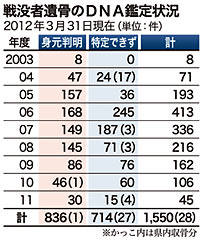DNA testing conducted on 28 sets of remains of war dead

DNA testing of remains of war dead
May 31, 2012 Yukiyo Zaha of the Ryukyu Shimpo
On May 30, a spokesperson for the Ministry of Health, Labour and Welfare announced that they had conducted DNA testing on 28 sets of remains of war dead from Okinawa Prefecture (one identified, 27 unidentified). The Ministry has been performing DNA testing on remains of war dead since 2003. In the nine years from 2003 to 2011, a total of 1550 sets of remains (836 identified, 714 unidentified) have been appraised. Bereaved families and a group for the recovery of remains state that DNA testing is not well known by many people and suggest that the government should provide more information. They requested that it be publicized that there is an increasing possibility of identifying remains through DNA testing, and that a thorough survey of remains be carried out.
Because the members of bereaved families are aging, DNA testing becomes difficult for them to get a match to remains. Gamafuya, a volunteer group dedicated to the recovery of remains of the Battle of Okinawa, petitioned 41 municipal councils in Okinawa Prefecture to request to the central government to carry out DNA testing of remains from the Battle of Okinawa. So far 15 municipal councils have passed the petition.
According to information from the Ministry, 636 sets of remains were recovered in Okinawa in the five-year period from 2007 to 2011, which equates to approximately 100 sets being recovered every year. To date, only one set of remains, which was identified in February 2011 using a DNA test to be a man from Chiba Prefecture, has been returned to the bereaved family. When they discovered a fountain pen with his name engraved on it, the volunteer group appealed for information on the man’s family and the remains were then identified using DNA extracted from the man’s teeth.
The Ministry explained a small number of surveys were conducted in the prefecture because it is difficult to extract DNA because DNA easily breaks down in hot and humid area. The Ministry stated that all other pieces of property left behind are also important to identify remains.
Of 836 sets of identified remains, 831 sets were those of detainees in Siberia recovered in the cold and dry former Soviet Union area. Based on a list of burial sites and other returned remains, the Ministry sent an announcement for DNA testing to approximately 8,500 bereaved families.
The person in charge explained, “If the conditions are right for DNA extraction from remains, and there are other items remaining and records, we contact the bereaved family.”
The president of the Gamafuya volunteer group, Takamatsu Gushiken, is critical of the passive stance of the government, saying, “It is the government’s responsibility to at least publicly announce when remains are recovered.” He states, “It is possible to identify remains through DNA testing, but time is not on our side because of the advanced age of bereaved families. I request that a register of DNA be created of bereaved families who wish to be involved, and match those results against those of any remains recovered.” He asked the government to actively promote DNA testing of remains and bereaved families in Okinawa.
(English translation by T&CT, Megumi Chibana and Mark Ealey)
Previous Article:Memorial for a Kamikaze pilot unveiled at Ogimi
Next Article:Kimura completes four-year circumnavigation of the world
[Similar Articles]
- DNA testing identifies Japanese soldier killed in Battle of Okinawa
- Remains from the Battle of Okinawa found in Nishihara
- Okinawa Prefectural assembly resolves to preserve remains of victims of the Battle of Okinawa
- Okinawa Prefecture sets up information center for the remains of victims of the Battle of Okinawa
- DNA analysis identifies human remains in the Battle of Okinawa
 Webcam(Kokusai Street)
Webcam(Kokusai Street)


